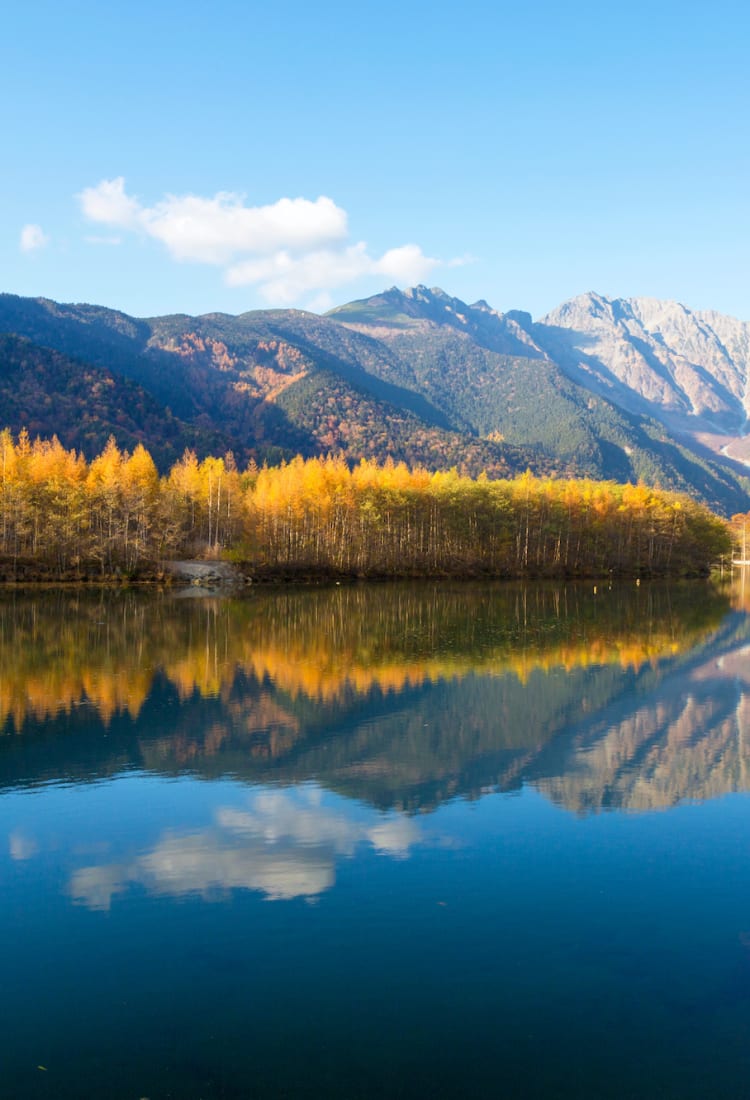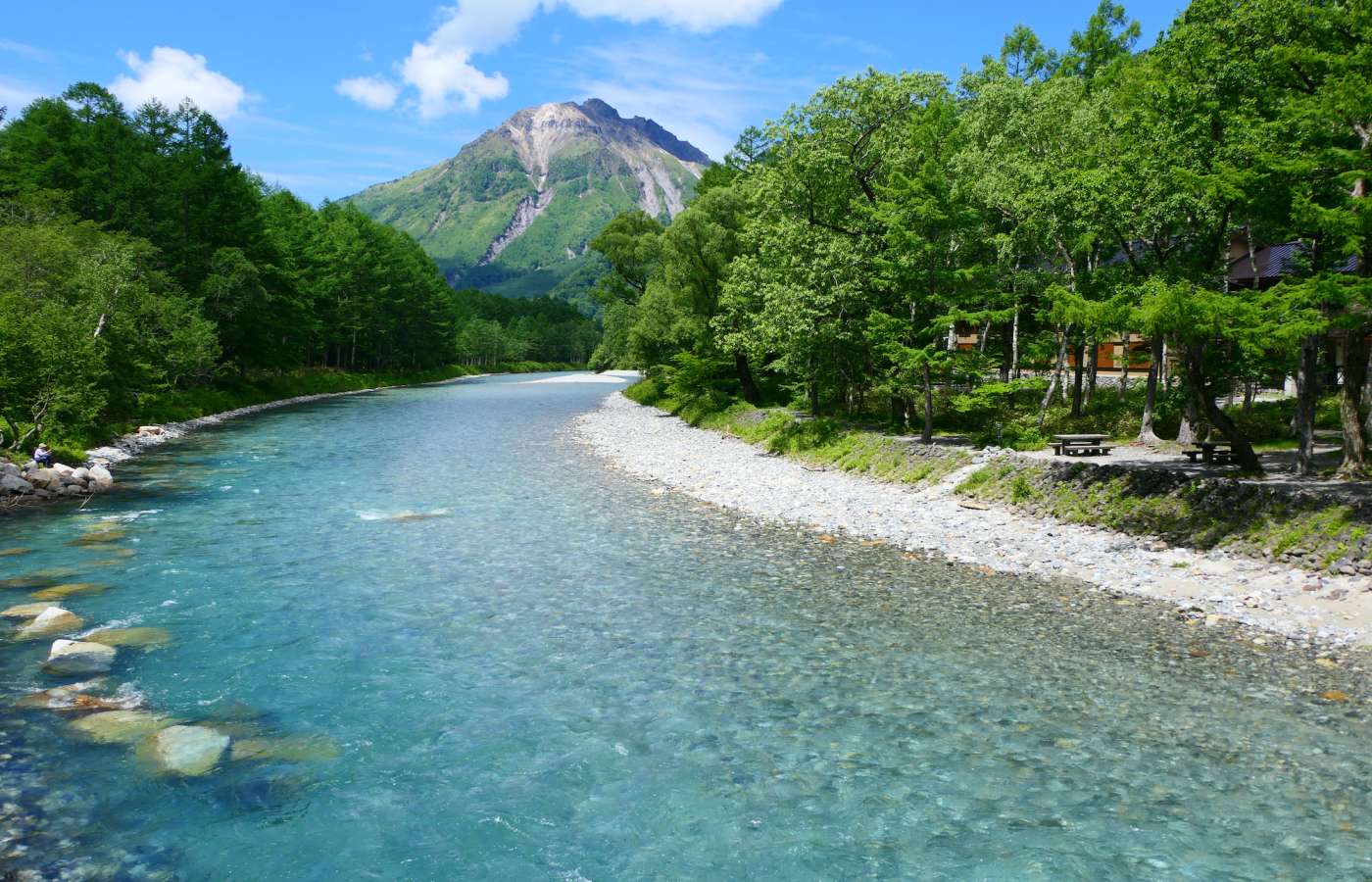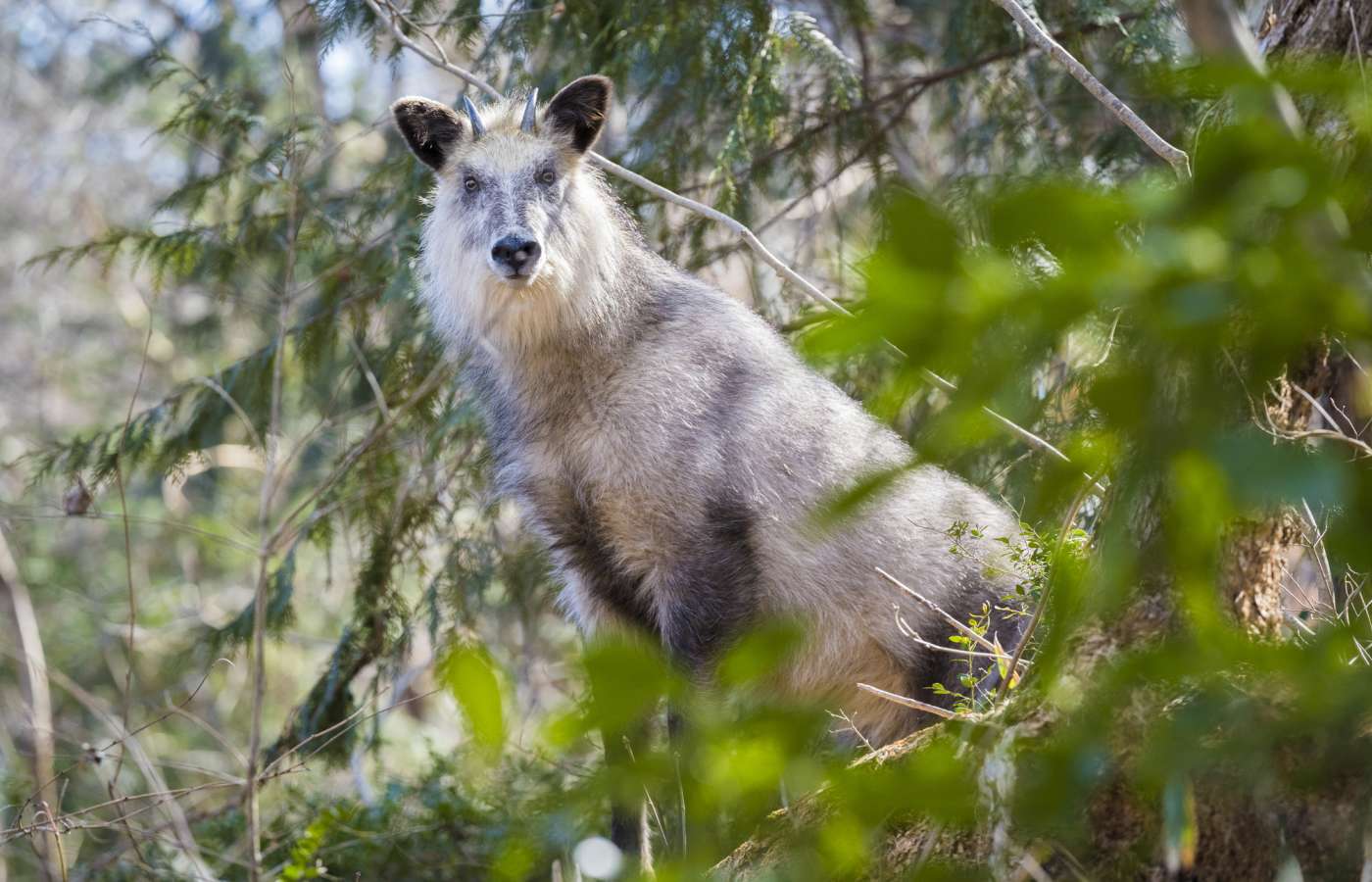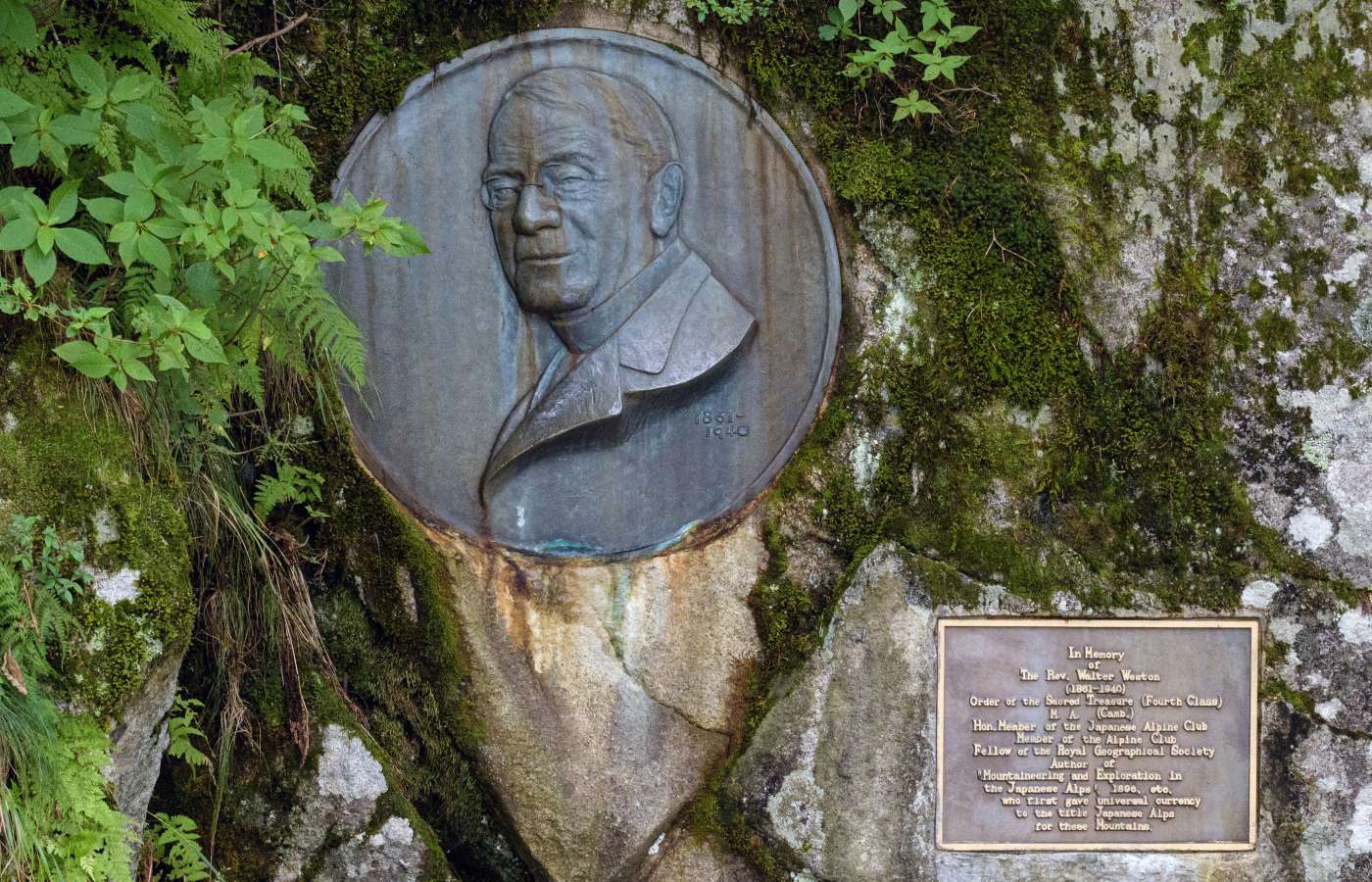
2021.10 Kamikochi: Gateway to the Japan Alps Trek through some of Japan’s most epic mountain scenery
The unspoiled nature of Kamikochi
Kamikochi puts the Japanese Alps at your doorstep. For over a century, this stunning highland valley at the heart of the Chubusangaku National Park has been luring mountaineers looking to tackle some of the country’s loftiest peaks.
The jagged crests and steep cliffs of the Hotaka mountain range and Mt. Yakedake rise majestically over a landscape of forests and wetlands, traversed by the limpid waters of the Azusa River.

The azure waters of the Azusa River, with Mt. Yakedake in the background.
Despite its popularity, Kamikochi has managed to avoid overdevelopment. It was an early pioneer of environmental protection measures: community clean-up initiatives started in the 1960s, and private vehicles were banned in 1975, later followed by sightseeing buses. As a result, the environment feels particularly pristine—and visitors are encouraged to keep it that way.
The vegetation is different from what you’ll see in many mountainous regions of Japan. Rather than the ubiquitous cedar and cypress, Kamikochi is home to larch, beech and white birch trees, which put on an impressive display when autumn rolls around.

While exploring the area, you may encounter some of the local residents, including Japanese macaques and the shaggy-haired Japanese serow (kamoshika), which looks like a cross between a goat and an antelope.
Where Japan’s mountain climbing boom started
When Japan introduced its new Mountain Day public holiday in 2016, the official celebrations were held in Kamikochi. And there’s a good reason for that: the area has played a pivotal role in the development of hiking as a recreational pastime in the country.
People had been scaling Japan’s peaks for centuries, but they tended to be Buddhist monks, who treated mountain climbing as a serious ascetic practice. One notable example was Banryu Shonin. In 1828, he became the first person to reach the summit of Mt. Yarigatake—popularly known as the Matterhorn of Japan—and affixed ropes and iron chains so others could repeat the feat.

The distinctive shape of Mt. Yarigatake has led to it being dubbed Japan’s answer to the Matterhorn.
Half a century later, William Gowland, an English surveyor employed by the Japanese government, followed in his footsteps. Gowland also coined a name for the region that would soon enter popular usage: the “Japanese Alps.”
But the person who really put Kamikochi on the map was an English missionary named Walter Weston. A keen alpinist, Weston hiked extensively in the area between 1888 and 1895, then regaled overseas audiences about his experiences. His seminal 1896 book, “Mountaineering and Exploration in the Japanese Alps,” introduced the region to Western readers for the first time.

The Weston Relief pays tribute to a pioneering mountaineer.
There’s a relief commemorating Weston near the trailhead to Mt. Nishi-Hotakadake, and a festival is held in his honor each June. Further upstream at Myojin Pond, you can also find a memorial to Kamijo Kamonji, the mountain guide who helped him on his expeditions.
Scenic spots along the Azusa River
Many of Kamikochi’s top sightseeing spots can be found along the Azusa River, which runs through the center of the valley. You’ll need 3-4 hours if you want to see everything, but the trails—a mixture of gravel paths, forest roads and boardwalks—are well maintained and almost completely flat.

Kappabashi Bridge, one of Kamikochi’s most famous landmarks.
The main focal point is Kappabashi Bridge, where visitors pose for photos against a background of soaring mountains. It’s named after a mythical creature from Japanese folklore: the kappa, a small, reptilian humanoid that was said to live around rivers and ponds, and played tricks on humans. The bridge was immortalized in a story of the same name by early-20th century author Ryunosuke Akutagawa, while you can pick up a variety of kappa-themed souvenirs at nearby shops.

If you’re taking the bus into Kamikochi, you may want to get off a couple of stops early at Taisho Pond. This local landmark was formed in 1915 when nearby Mt. Yakedake erupted, causing a mudslide that dammed the river. Due to sediment flowing into the pond, it’s now only a fraction of its original size, but is still a strikingly picturesque location—especially on clear days, when the Hotaka mountains are reflected in the water.

A small shrine stands at the edge of Myojin Pond.
Head in the opposite direction from Kappabashi for about an hour, and you’ll reach Myojin Pond. This sacred spot is attached to a shrine, meaning you’ll have to pay a small admission fee, but it’s worth it. The placid waters are dotted with rocks and tree-topped islets, like an immaculate landscape garden sculpted by nature herself. On October 8, Shinto priests and attendants cross the pond in a pair of boats, as part of the annual Hotaka Shrine Boat Festival.
Treks for experienced and not-so-experienced hikers
If you’re looking to go a bit further, join the backpack-toting hikers as they head upstream to Tokusawa and Yokoo, the starting points for climbs into the peaks. It takes around three hours to get to Yokoo from Kappabashi, following the Azusa River, and the gradient is gentle for the whole way.

Hikers take in the panoramic view from the peak of Mt. Yakedake.
The 2,455-meter Mt. Yakedake can be done as a day trip, setting out either from Kamikochi or the Nakanoyu trailhead—which is the easier trail, though hard to access without a car. Yakedake is the only active volcano in the area, and you can see plumes of smoke rising from vents towards the summit.
You’ll need two days if you want to climb the imposing Mt. Oku-Hotakadake—Japan’s third-highest peak, at 3,190 meters—and it’s definitely not for beginners. Meanwhile, the three-day loop from Kamikochi to Mt. Yarigatake (3,180 meters) and back is a rite of passage for experienced hikers. This course includes the infamous Daikiretto traverse, a vertiginous ridge that’s widely regarded as the trickiest non-technical climb in the whole country.
Exploring the seasons in Chubusangaku National Park
On April 27 each year, a chorus of alphorns announces the start of the season in Kamikochi. At this time of year, the surrounding peaks are still capped with snow, but in the valley the trees are verdant with new growth.
Each month brings different delights: soft windflowers in May, Japanese azalea in June, and early morning mists rising over Taisho Pond in the summer. The most popular time to visit is October, when the autumn foliage is at its peak, painting the valley in alternating shades of orange, red and yellow.

Sightseeing spots such as Myojin Pond, Taisho Pond and Dakesawa Marsh look especially picturesque during this period (and are suitably thronged with visitors), though the most iconic destination is Karasawa Cirque, in the heart of the Hotaka mountains. Each autumn, the slopes of this enormous, bowl-shaped glacial depression erupt in fiery colors. It’s a six-hour hike from Kappabashi, so you’ll have to camp overnight or stay at one of the local mountain huts, though the scenery more than rewards the effort.

Autumn leaves © Yashiro_Hino (Licensed under CC BY 4.0)
Kamikochi is open from mid-April to mid-November each year, at which time direct buses from Tokyo, Osaka and Kyoto are available. You can also visit in the off-season, but just remember to bring a pair of snowshoes: you’ll need them.
Business hours
Due to measures to prevent the spread of COVID-19, business hours may be subject to change; please check with the venues before visiting.
Related Links
Japan Alps Kamikochi Official Website |




























































